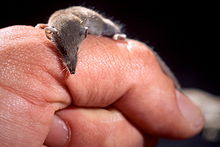
Back Suncus etruscus AN زبابه اتروسكان ARZ Suncus etruscus AST Vimkol (Suncus etruscus) AVK Cırtdan ağdiş Azerbaijani Етруска земеровка Bulgarian বামন চিকা Bengali/Bangla Tunig munut Breton Musaranya etrusca Catalan Suncus etruscus CEB
| Etruscan shrew[1] | |
|---|---|

| |
| Scientific classification | |
| Domain: | Eukaryota |
| Kingdom: | Animalia |
| Phylum: | Chordata |
| Class: | Mammalia |
| Order: | Eulipotyphla |
| Family: | Soricidae |
| Genus: | Suncus |
| Species: | S. etruscus
|
| Binomial name | |
| Suncus etruscus (Savi, 1822)
| |

| |
| Etruscan Shrew range (blue — native, black — probably extant origin uncertain) | |
The Etruscan shrew (Suncus etruscus), also known as the Etruscan pygmy shrew, white-toothed pygmy shrew and Savi’s pygmy shrew, is the smallest known extant mammal by mass, weighing only about 1.8 g (0.063 oz) on average.[3][4][5][6][7][8] (The bumblebee bat is regarded as the smallest mammal by skull size and body length.[3][9])
The Etruscan shrew has a body length of about 4 cm (1.6 in) excluding the tail. It is characterized by very rapid movements and a fast metabolism, eating about 1.5–2 times its own body weight per day. It feeds on various small vertebrates and invertebrates, mostly insects, and can hunt individuals of the same size as itself. These shrews prefer warm and damp climates and are widely distributed in the belt between 10° and 30°N latitude stretching from Europe and North Africa up to Malaysia. They are also found in the Maltese islands, situated in the middle of the Mediterranean Sea.[2][5] Although widespread and not threatened overall, they are generally uncommon and are endangered in some countries.
- ^ Hutterer, R. (2005). Wilson, D.E.; Reeder, D.M. (eds.). Mammal Species of the World: A Taxonomic and Geographic Reference (3rd ed.). Johns Hopkins University Press. p. 258. ISBN 978-0-8018-8221-0. OCLC 62265494. direct link
- ^ a b Aulagnier, S.; Hutterer, R.; Jenkins, P.; Bukhnikashvili, A.; Kryštufek, B.; Kock, D. (2017). "Suncus etruscus". IUCN Red List of Threatened Species. 2017: e.T90389138A22288134. doi:10.2305/IUCN.UK.2017-2.RLTS.T90389138A22288134.en. Retrieved 19 February 2022.
- ^ a b Jürgens, Klaus D. (2002). "Etruscan shrew muscle: the consequences of being small". The Journal of Experimental Biology. 205 (Pt 15): 2161–2166. doi:10.1242/jeb.205.15.2161. PMID 12110649.
- ^ Cite error: The named reference
j1was invoked but never defined (see the help page). - ^ a b Cite error: The named reference
r1was invoked but never defined (see the help page). - ^ "Белозубка карликовая (Suncus etruscus)". ours-nature.ru (in Russian).
- ^ Brecht, Michael; Roth-Alpermann, Claudia (2009). "Vibrissal touch in the Etruscan shrew". Scholarpedia. 4 (11): 6830. Bibcode:2009SchpJ...4.6830R. doi:10.4249/scholarpedia.6830.
- ^ Cite error: The named reference
Macdonaldwas invoked but never defined (see the help page). - ^ Cite error: The named reference
j3was invoked but never defined (see the help page).
© MMXXIII Rich X Search. We shall prevail. All rights reserved. Rich X Search
